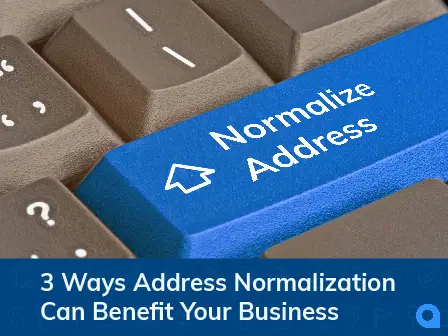
We recently released a free ebook, 4 Steps to Unlocking Latent Revenue and Driving ROI with Your Address Data, in which we show you how to use your company’s address data to unlock latent revenue and drive ROI.
In our last article, we went over address parsing. Today, we’ll explain address normalization and why this matters for data cleansing and analytics.
Address Normalization (or making an address look normal) is the process of formatting an address so that it matches the proper address format of the national postal authority, such as the USPS for those in the United States. This process is also referred to as address standardization.
Each national postal authority creates its own rules designating casing, punctuations, abbreviations, and proper ordering of address components for shipping purposes. If your idea of a wild Friday night is reading about proper address format, allow us to recommend Publication 28, the 200-page address formatting guideline published by the USPS for the United States. We can neither confirm nor deny that this IS our idea of a wild Friday night. Putting an address into a standard format makes it easier to sort address data and use it for data cleansing and analytics.

3 Business Benefits of Normalized Addresses
Improved Lead Segmentation
Want to group current or prospective customers based on region, ZIP Code, street, etc? Unnormalized addresses make it hard to do that accurately, resulting in inaccurate lead segmentation.
Reduced Shipping Errors
If your delivery provider can’t deliver an item to a requested address, you’re either out the cost of the item and its shipping or you may even have to pay a return fee. Get your deliveries right on the first try and you’ll reduce costs.
Confidently Managed Data
Standardizing your address data against an authoritative database like the USPS gives you clean data. You can make strategic business decisions confidently, knowing that your database holds quality data.
One important note: address normalization does NOT guarantee address validity. Address normalization only converts an address into the correct format. Normalization is an important step, but not the only step.
How to Normalize Addresses
1. Use Address Normalization/Standardization Software
Address normalization software will automatically correct messy, inconsistent addresses in a fraction of the time it takes to manually normalize those addresses. If you’re dealing with address lists containing thousands of addresses, you’ll want to automate this task.
2: Manual Address Normalization
If you only have a handful of addresses, or a really bored intern, you can go the manual route. The basic steps required to format most US addresses manually are:
- Get the address you want to normalize.
- Fix any misspellings.
- Check the street name, city, and state. Confirm that all address information is correct.
- Correct any abbreviations. a. Just like there’s one ring to rule them all in Lord of the Rings, there’s only one correct way to abbreviate each street suffix, according to the USPS.
- Fix the address casing and capitalization.
a. USPS accepts either UPPERCASE format or Proper Case (text written with each of the first letters of every word capitalized). - Get the ZIP+4
a. This is optional, but including it could speed up your letter or package delivery by 2 days. Because ZIP+4 Codes apply to only 10-20 delivery points, the Post Office can more easily pinpoint your mail destination with a ZIP+4. - Celebrate because you’ve normalized one address!
Once normalized, you have a complete, correctly formatted address, including the addition of any lost city, state, or Postal Code information. Now, you can move on to validating the address—but that’s a topic for another article.
As you can probably guess, the manual method works best for simple addresses. For high-volume or business use cases, you’ll want the efficiency provided by software. Time is money, after all!
To get the most ROI out of your software choice, look for a CASS-certified software provider, like Smarty.
Developed by the United States Postal Service, CASS address standardization is a certification program for standardization and address verification. CASS-certified software will standardize your mailing lists according to USPS guidelines, update outdated addresses, and verify that the addresses are complete and valid.
Start normalizing and validating addresses with Smarty US Address Verification today, or download our free ebook, 4 Steps to Unlocking Latent Revenue and Driving ROI with Your Address Data, to learn more about how address validation impacts business operations.

 Sawyer Hendrickson
Sawyer Hendrickson Kiana Andrewsen
Kiana Andrewsen